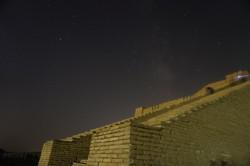Glossary term: Capricorne
Description: Le Capricorne est la plus petite constellation du Zodiaque. Les étoiles qui composent cette constellation se trouvent dans la partie du ciel qui croise l'écliptique (le plan défini par la trajectoire de la Terre autour du Soleil). En fait, toutes les constellations qui composent le Zodiaque croisent l'écliptique. Depuis la Terre, on trouve régulièrement les planètes, ainsi que le Soleil, dans la constellation du Capricorne. Dans le cas du Soleil, cela se produit de la fin janvier à la mi-février (à cette époque, nous ne pouvons évidemment pas voir les étoiles de la constellation). Le Capricorne est l'une des 88 constellations modernes définies par l'Union astronomique internationale, mais son origine est bien plus ancienne : elle faisait déjà partie des 48 constellations nommées par l'astronome Claudius Ptolemy au IIe siècle. Les étoiles qui composent la constellation du Capricorne sont relativement peu lumineuses. Avec un télescope, vous pouvez trouver l'amas globulaire M30 dans le Capricorne.
Related Terms:
See this term in other languages
Term and definition status: The original definition of this term in English have been approved by a research astronomer and a teacher The translation of this term and its definition is still awaiting approval
The OAE Multilingual Glossary is a project of the IAU Office of Astronomy for Education (OAE) in collaboration with the IAU Office of Astronomy Outreach (OAO). The terms and definitions were chosen, written and reviewed by a collective effort from the OAE, the OAE Centers and Nodes, the OAE National Astronomy Education Coordinators (NAECs) and other volunteers. You can find a full list of credits here. All glossary terms and their definitions are released under a Creative Commons CC BY-4.0 license and should be credited to "IAU OAE".
Related Media
Bras de la galaxie
Credit: Ruqayah Mohammed/IAU OAE
License: CC-BY-4.0 Creative Commons Attribution 4.0 International (CC BY 4.0) icons
The Pillar of Creation
Credit: Giorgia Hofer/IAU OAE
License: CC-BY-4.0 Creative Commons Attribution 4.0 International (CC BY 4.0) icons










